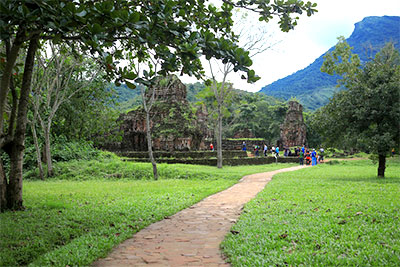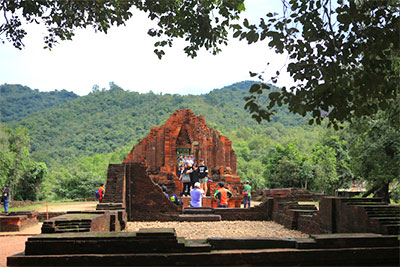Over time, the My Son Sanctuary has acquired an ancient, mysterious beauty, attracting many domestic and foreign tourists.

The My Son Sanctuary is located in Duy Phu commune, Duy Xuyen district, of Quang Nam province, central Viet Nam. It is 70 km from Da Nang City and 40 km from Hoi An. This is a Hindu holy place of the ancient Kingdom of Champa.
According to traditional rituals, whenever a king came to the throne, they had to go to My Son Holy to make rites, offer gifts and build temples.
This area was discovered in 1885 by a group of French soldiers. Ten years later (1895), archaeologist Camille Paris made the first exploration. Since then until 1904, many researchers and archaeologists have visited here to reveal the secrets, including Louis Finot, Henri Parmentier and others.
My Son Sanctuary is located in a valley of about 2 km in diameter, surrounded by hills and mountains. It consists of 70 towers, which are divided into several clusters and built according to the same principle.
The structure of each tower cluster consists of the main temple, surrounded by smaller stupas or sub-works. The main temple represents Mount Meru, the center of the universe, the place of Gods and the place for worshipping God Siva.
The tower gate is in front of the main temple, with two doors in the east and west. Mandapa is the long house, used as a place to welcome pilgrims and receive offerings. Next to the main temple is the tower with one or two rooms, used for storage of offerings. The sub-temple worship the gods who take care of the sky directions.
Architectural styles here are divided into six categories, including: old style, Hoa Lai, Dong Duong, My Son, Po Nagar and Binh Dinh.
Common motifs are flowers, animals like elephants or lions, Kala - Makara (a symbol of the Cham Pa), Apsara dancers, musicians, gods and the monster Makara.
During the period from 1965 to 1972, Duy Xuyen became a battleground. Along the surrounding villages, this place suffered heavy losses. In particular, the bombing in 1969 ruined most of the temples.

In 1980, under the framework of cultural cooperation between Viet Nam and Poland, a subcommittee for restoration of Champa monuments was founded, led by late architect Kazimierz Kwiatkowski. The monuments were cleaned, restored and reinforced. Thus, the area retains its form today.
To help the monuments stand with time, in 1995, the My Son monument management board was established. In 1998-1999, Viet Nam submitted My Son Holy records to the UNESCO for World Heritage recognition.
In December 1999, it was officially recognized as a World Cultural Heritage site because of two criteria: the striking example of cultural exchange and integration with the local culture; The external cultural influences, especially the art and architecture of Hindus from the Indian subcontinent vividly reflects the evolution of the cultural history of Champa culture in Southeast Asia.
For conservation, a green belt was established. Thus, the green color began to surround the ruins. Currently, it is open for tourists all year round. The ticket price for a domestic tourist is VND60,000 and VND100,000 for a foreign tourist.